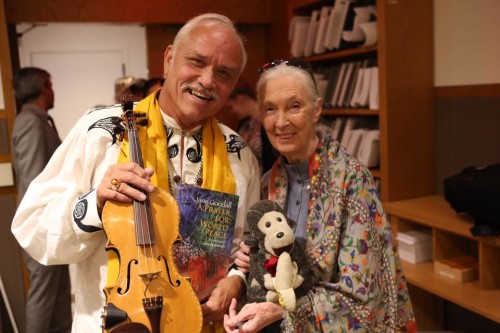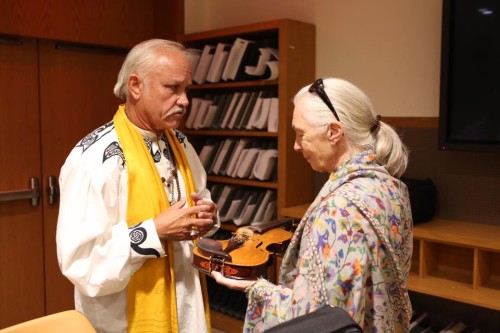[Our Fall Funding Drive is still going on. Your support and your donations are what make our work possible. How much would you pay for a subscription to a magazine or a newspaper? If you like reading articles, like the one below, on a daily basis, please consider donating today to help keep The Wild Hunt going for another year. Donate here. Thank You.]
NEW YORK, NY –The World Peace Violin, an instrument that has both given and received blessings as it travels around the world to various sacred places and conflict zones, was blessed on the U.N.’s International Day of Peace by cellist Yo-Yo Ma and primatologist Jane Goodall. “On the 70th anniversary of the United Nations and 75th of the bombing of Hiroshima, those messengers of peace blessed and sanctified it,” said violin creator Patrick McCollum.

Jane Goodall with Patrick McCollum and the Peace Violin [Courtesy Photo 2015]
Throughout the last several days, many of the world’s foremost peacemakers and interfaith leaders have been deeply moved by the violin and its story, and many have shared their personal blessings on it. It was beautifully played by Scarlet [Rivera] at the Roerich Museum, and my speech was very well received. All in all, I did a number of wonderful events for the International Day of Peace including the prayers and flag ceremony for every country at the United Nations Chapel after the main event at the UN.
The story of how McCollum, who had never played a note on a violin, much less built one, came to be the steward of one is rife with mystery, magic, and many, many blessings. It’s a tale he shares often, although not always as thoroughly as he did for The Wild Hunt.
In summary, he said, “Years ago, I’m laying in bed, and a voice speaks to me …It’s the Goddess, and she said, ‘I want you to make a violin, and it’s going to become the symbol of world peace.’ She told me I could not learn how to make one; I had to listen to her voice.”
And, listen he did. The pieces, quite literally, started coming together. Those pieces came from a wide variety of woods, some sacred, others from trees that were witness to conflict or its resolution. A highly-skilled luthier would be hard-pressed to coax music from an instrument fashioned of as many diverse woods as this violin, but those who have played it consider its sound to be world-class. Here’s a sample:
The violin sounded quite poor when it was first built, McCollum said. The first two pieces of wood to go into it came from opposite sides of the world. One was given to him by members of a tribe in the Congo, and came from the type of tree made to use drums sacred in their tradition. The other came from a tree that members of a Native American tribe introduced him to; he was told that it carried the “voice of peace.” McCollum recalled, “I interacted with the tree for many years, until a storm knocked off a big branch.”
He carved into an inlay a piece he took from a sacred tree that had seen the peace accords signed in Ireland, and created a varnish which reinforced the message all the more: dust collected from Hiroshima eight days after the bomb detonated, sand from the reputed site of Jesus’ baptism which was collected during peace talks between Israel and Palestine, and cremains from a sacred white buffalo, whose birth itself was a prophecy of peace.
“When I first played it, it sounded horrible. It sounded terrible, but it looked really nice.”
Despite that beginning, McCollum began asking people to bless the violin, starting with prominent Pagans, such as Starhawk and Selena Fox. He brought it on his travels, obtaining blessings from more Pagans and others, until he brought it to the Maha Kumbh Mela in India. During that festival, which takes place every twelve years, Hindus bathe in the Ganges to wash away the sins of lifetime. As many as one hundred million people participated in 2013 when McCollum was there, and he again heard a voice. “It told me to immerse the violin under the water as they pray,” he said. “Some people nearby told me not to do that,” but submerge it he did. McCollum added, “It took a month and a half to dry, but when it did, it sounded world-class.”
The violin continues to sound as lovely, despite having been dismantled and reassembled with new pieces of wood at least fifteen times. It now contains over a hundred fragments from all over the world. It’s an ugly process, involving breaking and chiseling it apart, “but each time I put it back together, it sounds better,” he said.
He also reports that Rivera, the primary musician, said that it sounds a little different each time it is blessed by someone new. That’s not something he can confirm personally, since he taught himself how to play, and claims he restricts that to his living room.
Built of an impossible diversity of woods that should not sound well together after being broken down and reconstructed time and time again, McCollum sees the violin as a metaphor for the peace process itself. He’s not alone in that, either, as evidenced by the events he has been asked to bring the instrument to, and the people eager to both play and bless it. He said,
To me, it’s important because it’s a Pagan violin. We’re always trying to gain recognition, and be taken seriously. This originated in Paganism, and it was our blessings that laid its foundational energies.
There are stories and hints that the blessings of this violin go both ways. McCollum has heard of people with serious health conditions whose suffering was alleviated after they conferred a blessing upon the violin or heard it play. He is more than willing to allow anyone to bless the instrument; not just faith leaders. Laypersons also have laid hands upon it, and those who see it as a miracle of science and bless it from that perspective.

Jane Goodall blessing the Peace Violin [Courtesy Photo 2015]
YouTube videos offer only tantalizing bits to those who have not been fortunate enough to hear the World Peace Violin be played in person. In the works is a CD that might give the curious more of a sense of how this remarkable instrument actually sounds. Perhaps that recording will carry some of its magic and allow its message of peace to be carried further than even its world travels might take it.
Through his Foundation’s Facebook page, you can follow McCollum’s work and, if you’d like to bless or see the violin, the page also offers the most up-to-date information on its future appearances.
* * *
The Wild Hunt is not responsible for links to external content.
To join a conversation on this post:
Visit our The Wild Hunt subreddit! Point your favorite browser to https://www.reddit.com/r/The_Wild_Hunt_News/, then click “JOIN”. Make sure to click the bell, too, to be notified of new articles posted to our subreddit.
I got to handle and bless the violin last night at the Mills Pagan Alliance. There really is something remarkable about it, that I didn’t even fully pick up on until I held it in my hands.
Also, Patrick is a fascinating guy, and very kind.
Slight mix-up with the anniversaries I think; this August was the 70th anniversary of Hiroshima… It’s a direct quote so you probably can’t edit that but the 75th anniversary of Hiroshima won’t be until 2020…
This is very intriguing!
I wonder if he and the Violin will be at the World Parliament of Religions in two weeks…?